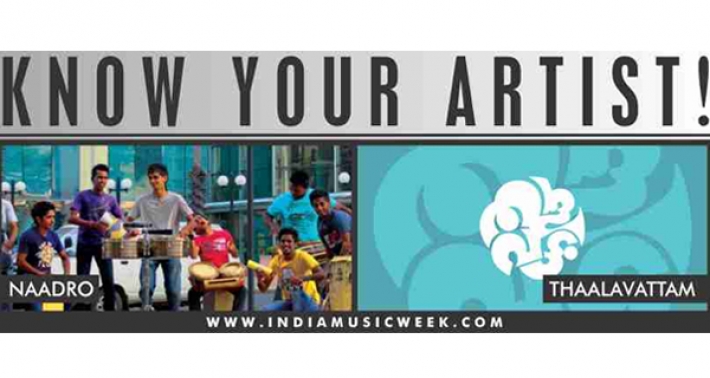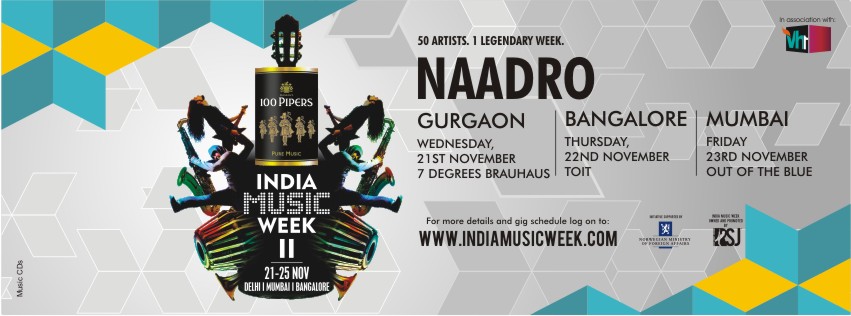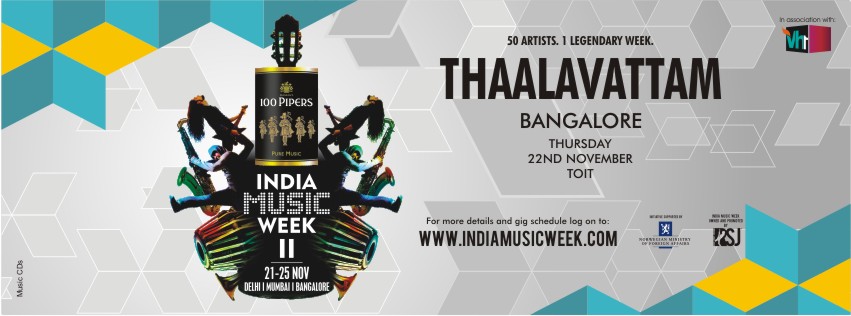

MEDHA SINGH
I have a quiet admiration for bands that can, without the bearing of an externally determined standard, make claims to their authenticity as an act. Next up, among our acts at the IMW are Naadro and Thalavattam, that serve as few of the first examples that come to mind. Naadro is acutely conscious of their Sri Lankan sensibility, anticipating rhythm and beats to function at the very core of their structure, for without rhythm, there is no dance, and dance is central to the Sri Lankan conception of life and festivity; both of these mediums are eternally intertwined. Naadro incorporates elements of afrobeat, cubano, mariachi, Indian and, of course, Sri Lankan in almost all of their songs.

Rakitha Wickramaratne, the founding member, is said to have began his musical pursuits at the age of six, picking up the drums. He went on to study at the Prince of Wales College and the Royal College Colombo, and today, Rakitha is one of the best percussionists, or rather, one of the best musicians in Sri Lanka. The other members of the band, almost all of whom are, or were at some point, university students, are: Gayan Manokumara, Uthpala Iroshan, Ranga Nuwantha, Nupathi Nilambara, Chathuranaga Chithrajith, Guyrika Weerasingha, Nuwan Darshana, Tharindu Dhananjaya and Lahiru Sasanka Fernando. Each one of them is a musician in their own right, proficient and well versed with many folk and classical styles. Their instruments can range from the traditional Sri Lankan Udekki, a small, two faced hand drum to a common kitchen utensil, from our well known African Djembe to the closer-home-Dhol.
Thalavattam (Also known as Rhythm Rush), a Bangalore based outfit, have their own ethic working here; Manuel Montry’s initiative is to further the beaten-to-death concept of the three R’s (Namely, reuse, reduce and recycle) into the functioning of our everyday lives. It’s a noble agenda. The idea is simply this: ‘Thalavattam’ literally translates as ‘Circle of Rhythm’ in Malayalam, which is to say that the band, apart from its own performances on stage, requires the participation of their audience as well for the show to go on. The use of instruments such as the Djembe, much like Naadro, and the Didgeridoo (native to Australian Aborigines), is a strong suggestion at the universality of music, much like the undisputable fact of the existence of nature, intrinsic to all things living.

The green initiative needs participation, like most of their performances. This is executed by Montry’s skill as a designer; he tells RSJ that “As a creative person, one needs to be responsible too. One day, a while back, during my Swarathma days, I was walking down the street and I saw a pile of empty Pepsi bottles, picked one up and found it to be strong, sturdy, useful. Ever since, my fascination with odd objects has grown and I’ve made drums out of them. Usually, during our performances we distribute them among our audience. They range from PVC pipes to paint cans, each of which have very distinct sounds as various companies package their products differently.” He goes on to add, “I don’t prefer to talk about it much. There are other ways in which Thaalavattam takes up the environment issue. For instance, I’ve been around town to random tailors, looking for waste cloth, collected that material, given it to working class women, gotten them involved and paid them for it. The idea is to get them involved; their handiwork, we used as merchandise for the band. People knew what it was, people knew what our drums are about, people know what we are about. I prefer not to surround it in a smokescreen of words.”
Rakitha (Naadro) is trained in Latin percussions especially, which is why one finds strains of the guitar prominent in songs like ‘Beats On a Box’; the name is intended to deceive. ‘Havana Night’ has an odd assortment of the piano and shaker, accompanied with a whole range of trumpets, tom-toms and bass-drums, and one notices subtle undertones of the Conga as well. ‘Clay Play’ is carefully peppered with the Ghatam, guitars, sticks-on-a-drum-hard-to-identify-on-its-own, the Cajon, and finally the Bansuri, i.e. the Indian flute. It is very engaging to listen to them and identify their instruments, following closely the various groove/tempo shifts. ‘The Seventh Count’, seats us with catchy bass undertones, the Thammátama, a double-headed drum played by two sticks, a shaker, and a saxophone, among other things such as the melodica.
‘Thaj Jith Thong Nang’ begins with the long ranging sound of a conch shell, paving way for strings and the rat-a-tat-a-tat-noise of the low country drum played by a stick and a hand, and a bell chimes in at moments chosen carefully; it’s all too much and all too beautiful. The remaining few tracks also work with bluesy guitars, synthesizers, and a myriad bunch of drums, sparingly using wind instruments, and so forth. ‘River Dance’ culminates into all of what they stand for: the shaky, reverberant, folk sound that they represent. Other noteworthy tracks include ‘Naadro’, ‘Jhummar’ (with a beautiful harmonium, flute, bass and drums), ‘Voodoo Sunday’ and ‘Shaman’s dream’. All quite enchanting. They have played shows all over the world, ranging from as far as Sydney to the upcoming performance at the India Music Week, where they will be touring the country playing at Delhi, Bangalore and Bombay. Sharing the stage with them would be Thalavattam (who usually share the stage with everyone).
--
Montry was trained in Cochin under the tutelage of Mr Jerry Peter, and later fine tuned his madskillz under Mr. Jeoraj Stanley. His styles range from reggae, Indian folk to samba and convulsive (in a good way). He and his compadres (who are a huge bunch, but the prominent and recurring ones are Mehdi and Nishant) are an eccentric bunch whose instruments range from your serious, conventional percussion instruments to paint cans, PVC pipes, oddly shaped bottles and so forth. We ask them what they have in store for us at the IMW. “We usually play an hour long set, within which 15 minutes are allocated for the solo band, and the rest of it is spent Stomping. I am really inspired by Stomp and the Blue Man group.” He also mentions something about not going with the intention “to share the stage with the other act, as it is about everyone in the audience too. If they [Naadro] join in, that would be wonderful; we are used to participation, by both musicians and non-musicians alike.”
Both of them seem excited, and it’s infectious. Get your innards vibrating, and we shall see you there!
Learn more about artists performing at the India Music Week at www.indiamusicweek.com
Previous Article In Conversation with Simple Plan In Conversation with Simple Plan
|
Next Article Know Your Artist: Shrilektric (Featuring Lord K.I.M.O.) Know Your Artist: Shrilektric (Featuring Lord K.I.M.O.)
|


Leave a comment